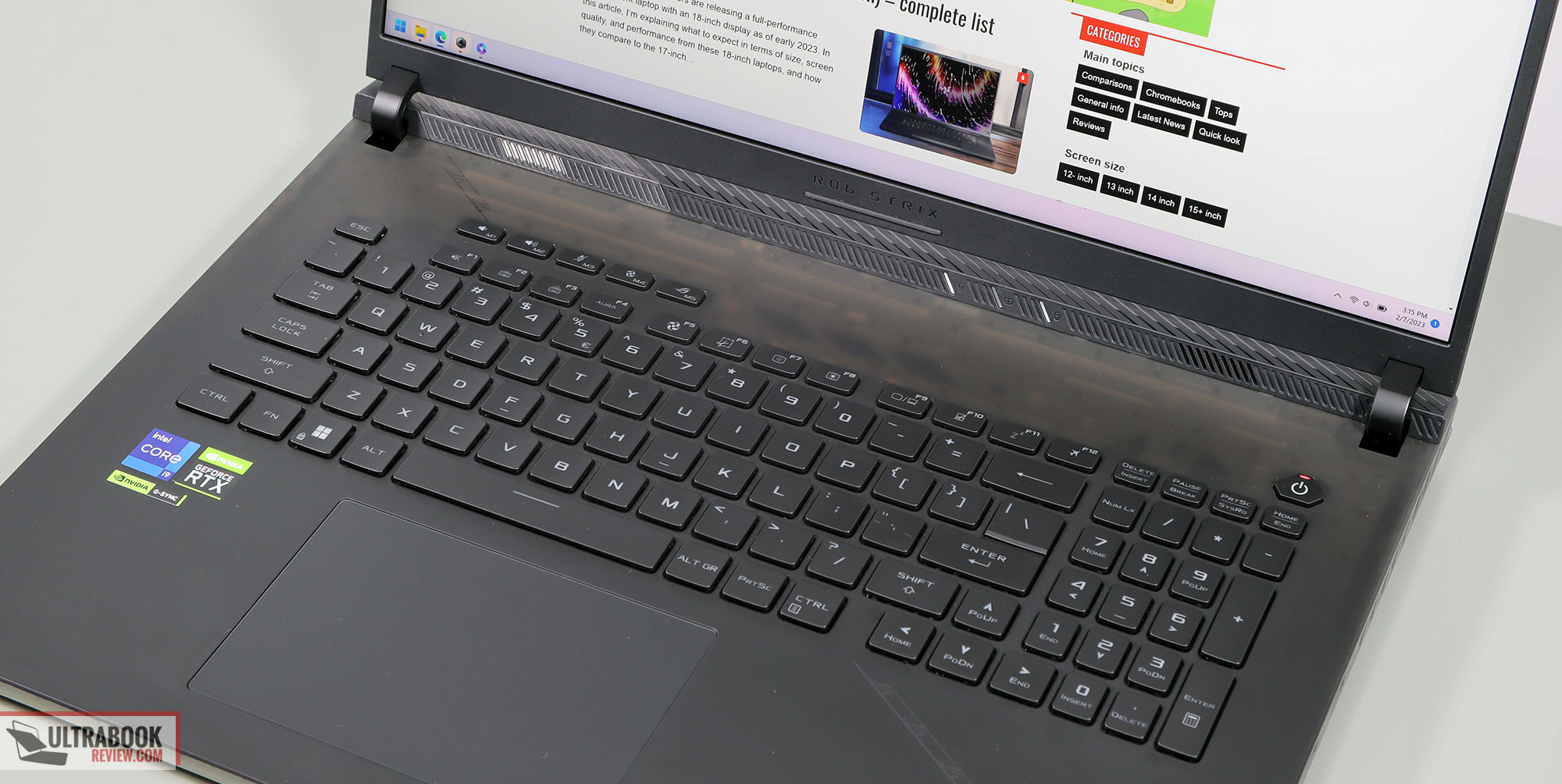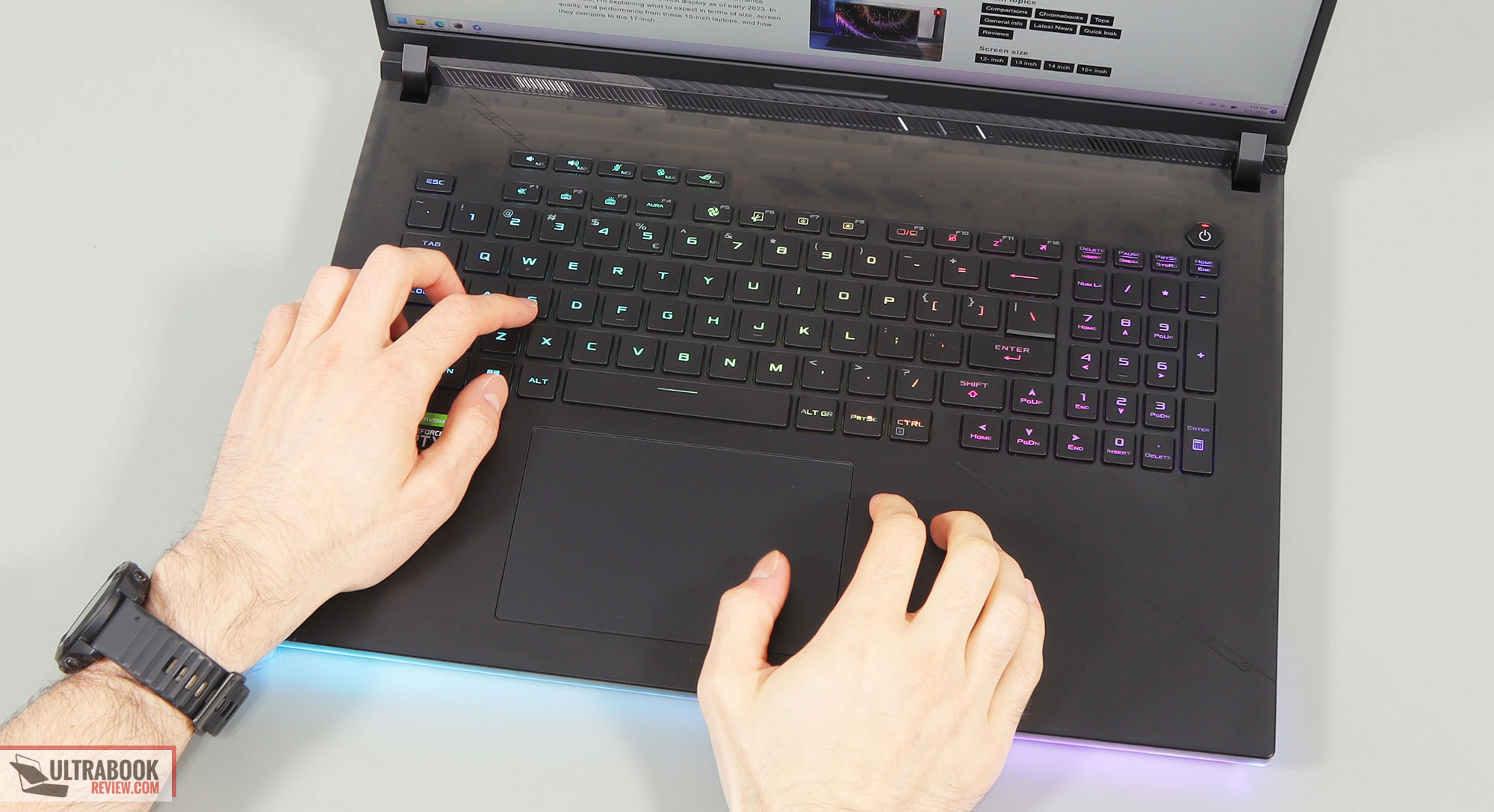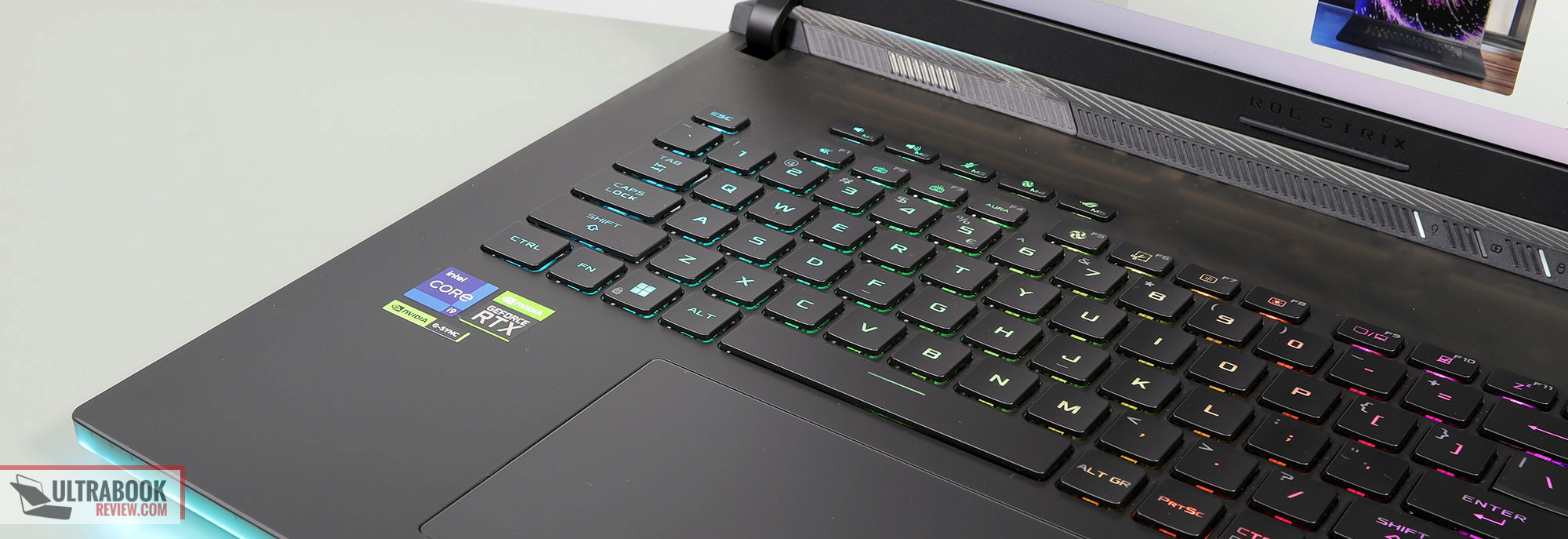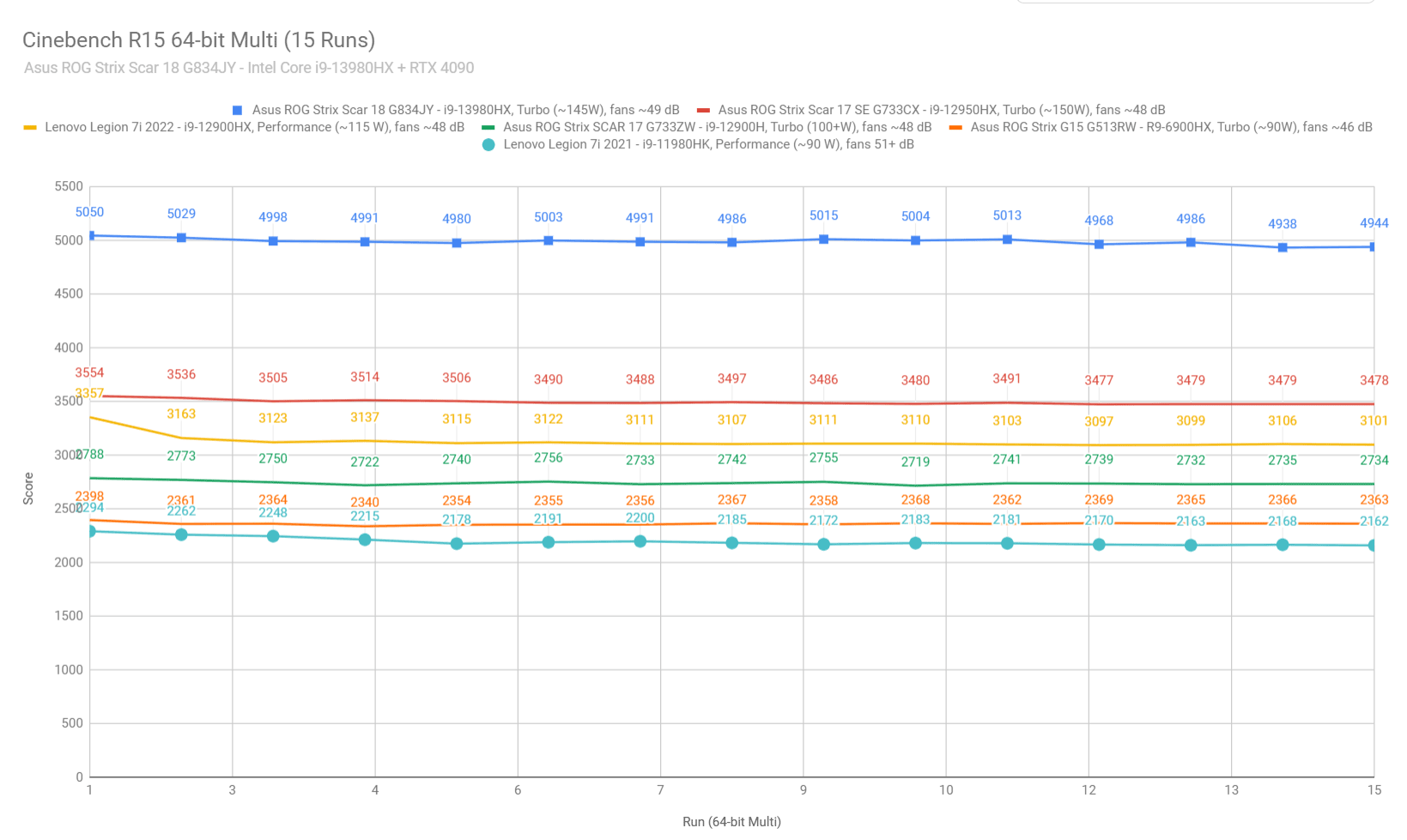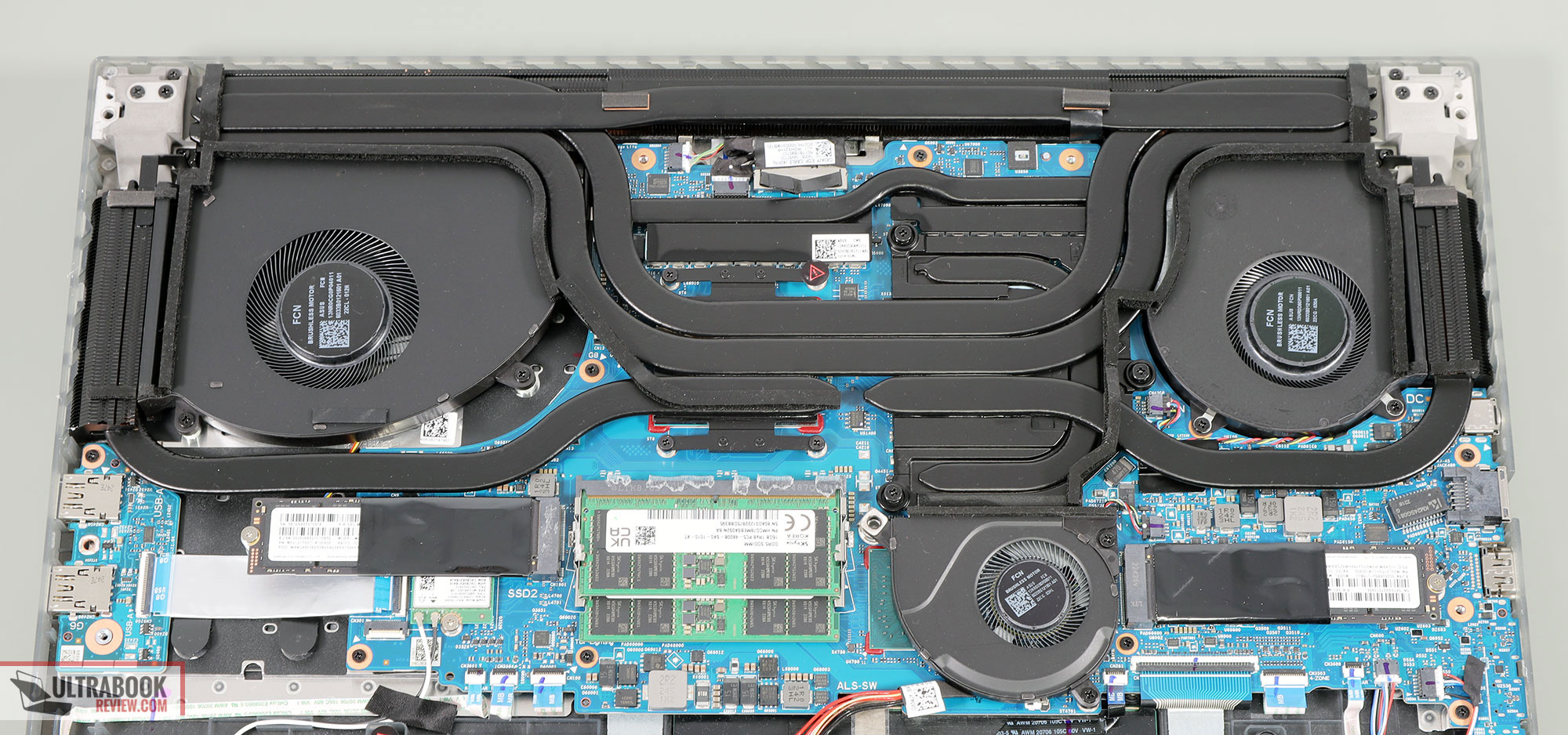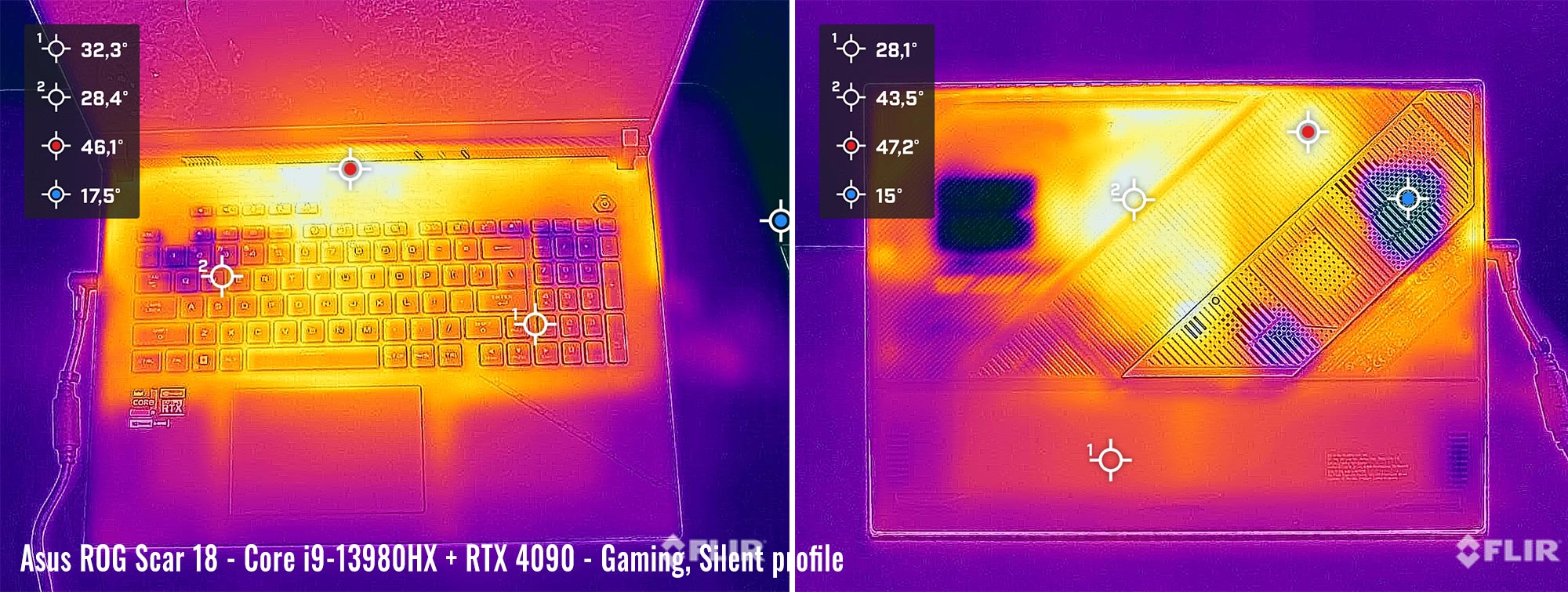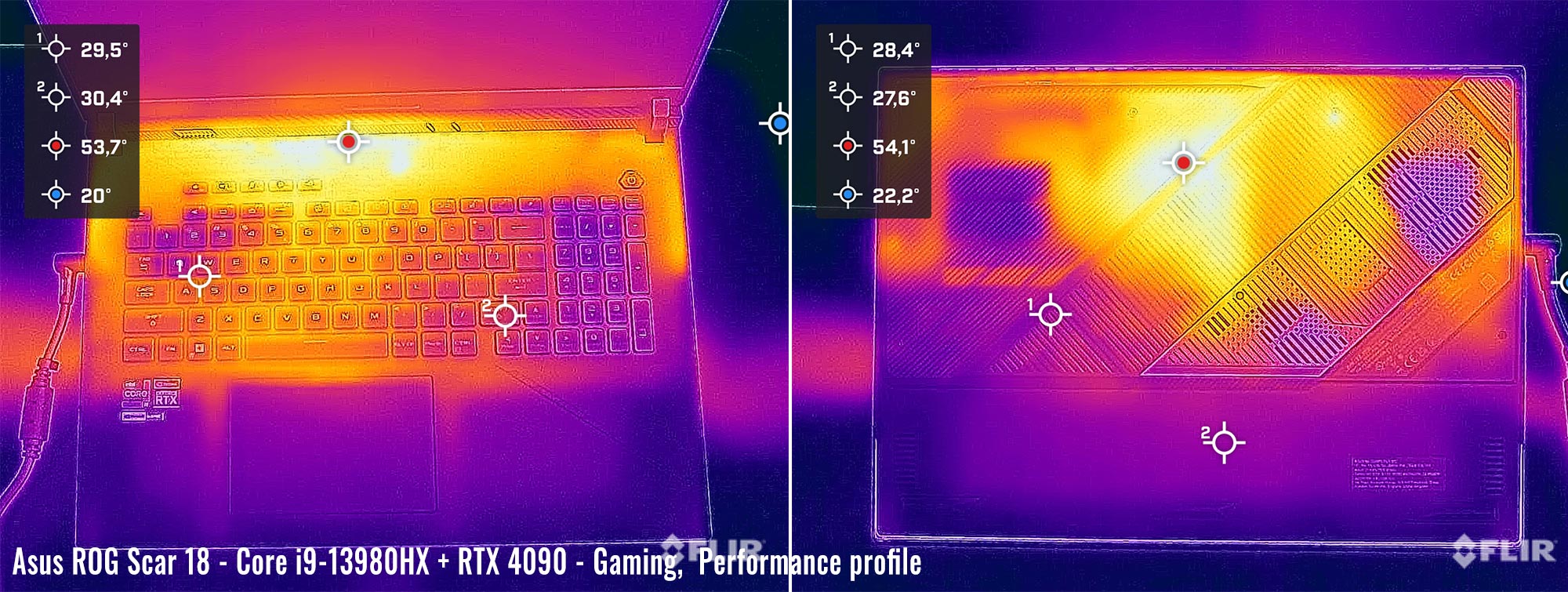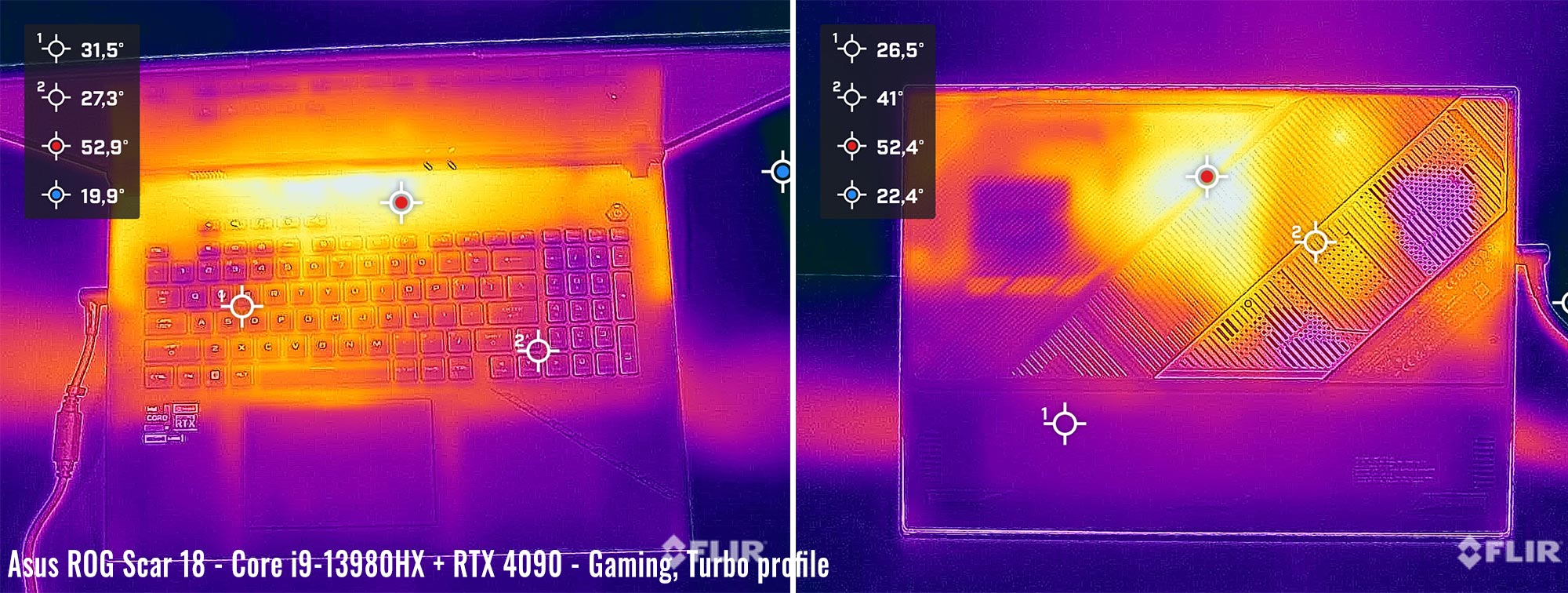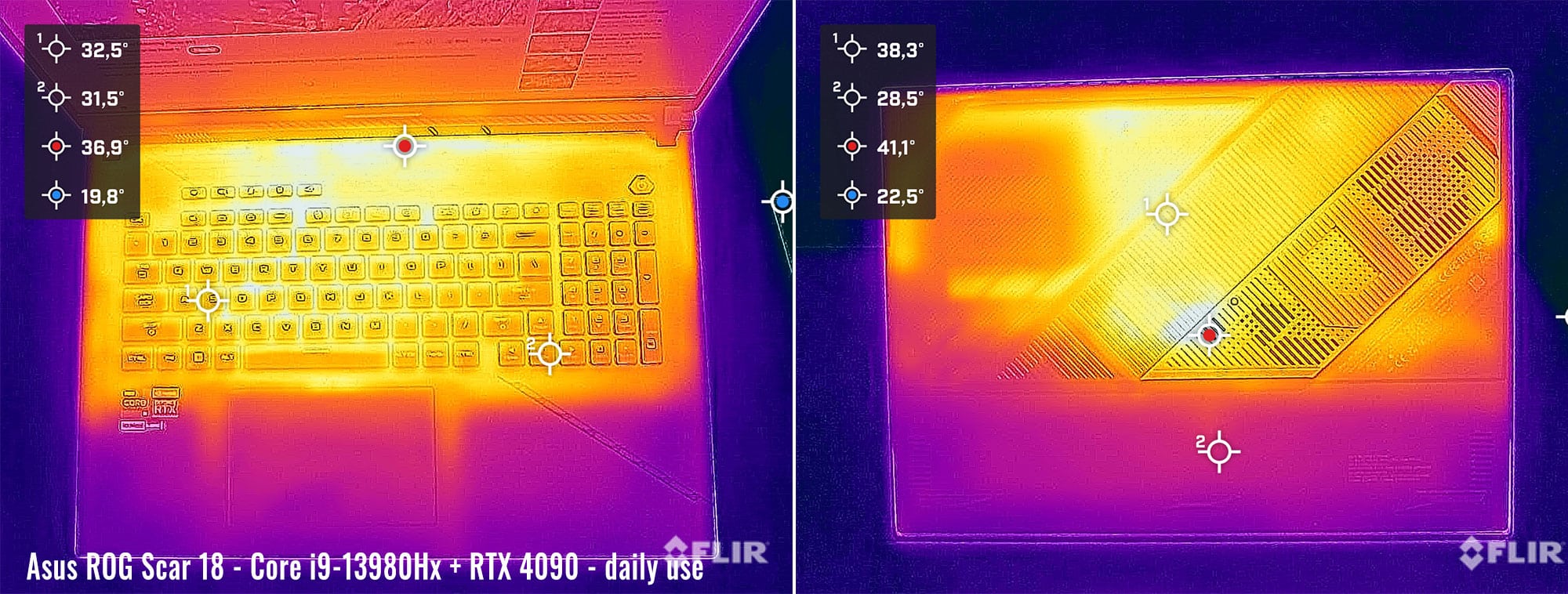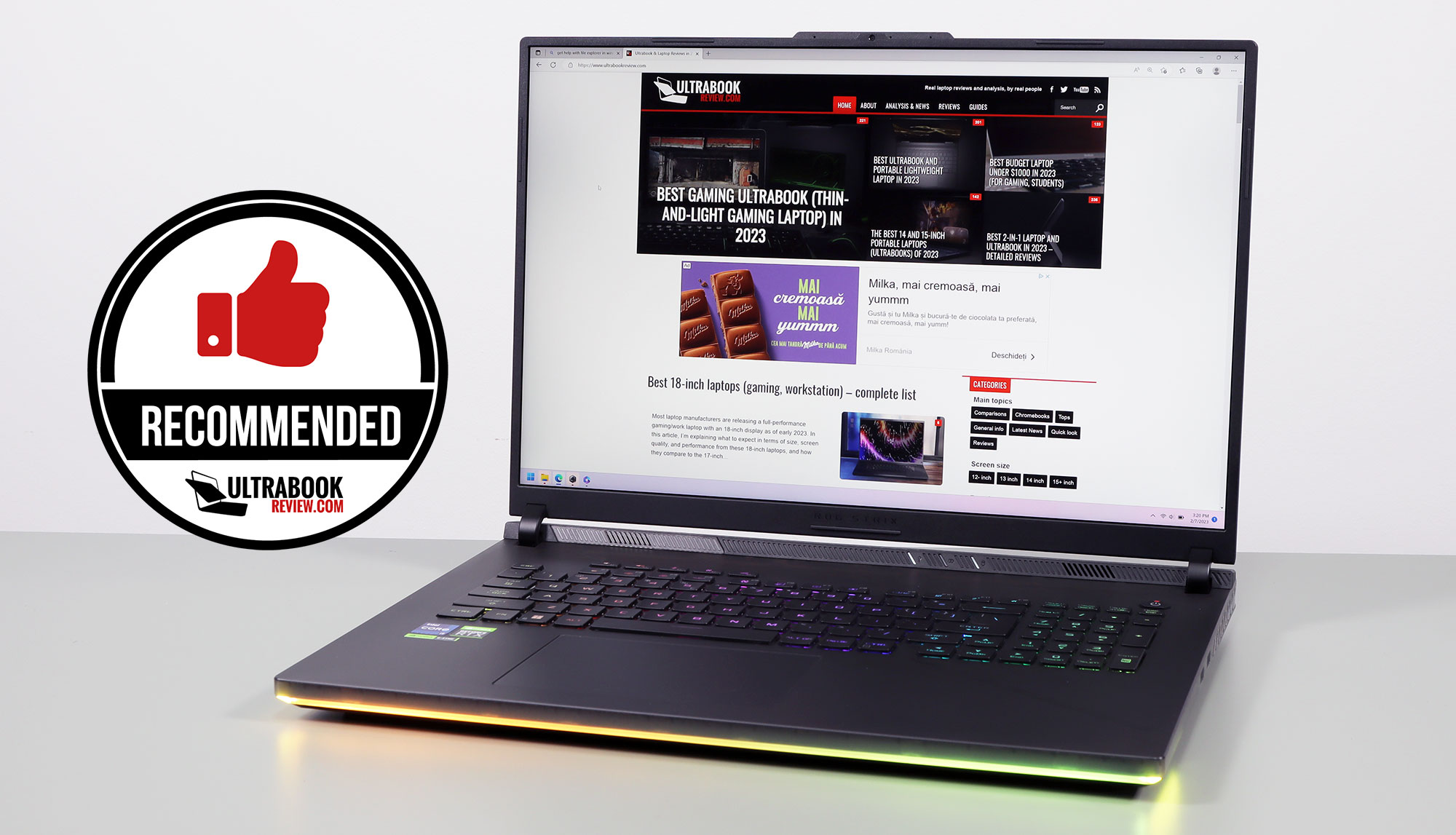This is my detailed review of the Asus ROG Strix Scar 18 series, the most powerful ROG – Republic of Gamers laptop available as of 2023.
The Scar 18 is a performance laptop with an 18-inch display, a full-size chassis, and an updated beefy tri-fan thermal module, required to cope with the bundled hardware.
Our review unit is the highest-tier configuration available for this lineup, with the Intel Core i9-13980HX processor and an Nvidia RTX 4090 Laptop dGPU, running at up to 175W TGP.
In just a few words, this is an excellent large-format work and gaming laptop, primarily meant for desk use. It looks and feels much like previous ROG Scar notebooks, but the 18-inch display offers a larger screen real-estate than past 17-inch options used to, and the entire package of capabilities and thermals is better balanced in this updated chassis than on the past Scar designs.
At the same time, this Scar 18 is slightly larger and heavier than the previous Scar models, but if you’re after a little more compact, Asus also offers a ROG Scar 16 this year.
Down below, in this detailed review, we’ll get in-depth on the nooks and crannies that you should be aware of when considering buying this laptop. Just keep in mind that we’re testing an early unit with early software, just before its launch date in Feb 2023, thus some software-related aspects might change with later updates.
Specs sheet as reviewed – Asus ROG Scar 18 G834
| 2023 ASUS ROG Strix SCAR 18 G834JY | |
| Display | 18-inch, 16:10, non-touch, matte, QHD 2560 x 1600 px IPS, 240 Hz 3ms, 450-nits with 100% DCI-P3 |
| Processor | Intel 13th gen Raptor Lake, Core i9-13980HX, 8C+16c/32T |
| Video | Intel UHD + Nvidia GeForce RTX 4090 Laptop 16GB (up to 175W with Dynamic Boost) with MUX, Advanced Optimus, GSync |
| Memory | 32 GB DDR5-4800 RAM – up to 64 GB (2x DIMMs) |
| Storage | 2 TB SSD (Samsung PM9A1) – 2x M.2 PCI 4.0 x4 slots |
| Connectivity | WiFi 6E (Intel AX211) 2×2 with Bluetooth 5.2, 2.5Gigabit LAN |
| Ports | Left: power, 2.5G Lan, 1x USB-C with Thunderbolt 4, 1x USB-C gen2 (with video, data, power), HDMI 2.1, headphone&mic Right: 2x USB-A 3.2 gen2 |
| Battery | 90Wh, 330 W power adapter, USB-C charging up to 100W |
| Size | 400 mm or 15.75” (w) x 294 mm or 11.57″ (d) x 23.1 – 30.8 mm or .9″ – 1.21” (h) |
| Weight | 3.05 kg (6.73 lbs), 1.12 kg (2.47 lbs) power brick and cables, EU version |
| Extras | rubber-dome per-key RGB backlit keyboard with NumPad, updated touchpad, HD camera, quad speakers, updated tri-fan cooling module |
This SCAR 18 G834JY is the top-specced configuration of the 2023 ROG Scar 18 series, and also the most powerful ROG laptop of this generation.
A somewhat more affordable configuration is available as well, with the ROG Scar 18 G834JZ variant that offers the same features, but pairs the same Core i9-13980HX processor with an RTX 4080 12GB dGPU. Mid-tier and lower-tier specs are not available for the 2023 Scar, but are offered on the ROG Strix G18 lineup, which we’ve covered here and we’ll also cover in future reviews.
Design and construction
The ROG Strix Scar 18 is a full-size laptop with a large 18-inch 16:10 display. It’s roughly 400 x 295 mm in footprint, up to 1.2″ (31 mm) thick, and 3.1+ kg (7 lbs) in weight.
These make it a bit larger, thicker and/or heavier than the previous ROG Scar 17 (400x 280 mm, 28 mm thick, 2.8 kg) and ROG Scar 17 SE (400 x 280 mm, 28 mm thick, 3.1 kg) models from 2022. Add in the heft of the 330W charger, at 1.1 kilos, and we can conclude that this is primarily meant for desk use, and less so for any kind of traveling.
Here’s a picture of this Scar 18 next to the Scar 17 from last year. Note that the Scar 18 chassis used in this illustration is a pre-production model, and not the final variant that you will see in all the other included images. There are also no emphasized QWER ASDF keys on the final design, as otherwise suggested by their earlier prototype.
Aside from the change in size and weight, there are a few other major updates of the 2023 Scar series:
- the screen has been replaced with a 16:10 format that translates into a larger real-estate and smaller bezels, especially on the bottom chin;
- there’s a reversed notch at the top of the display now, which incorporates a camera and microphones, and acts as a leaver for you to grab the screen from when opening the laptop;
- the keyboard has been slightly redesigned, and a larger touchpad was implemented;
- the entire rear edge of the laptop has been redesigned, in order to incorporate the new thermal module;
- as a result, there are no ports on the back anymore, and all the IO is on the lateral sides.
Here’s a more in-depth look at the IO.
I appreciate that the useless Keystone was ditched from this new chassis design, and instead replaced with two USB-A slots on the right edge.
Most ports are on the left, though, where you’ll find the power plug, the LAN port, the full-size HDMI 2.1, and the two USB-C ports. One of them supports Thunderbolt 4 with 40 Gbps USB, no charging, and DP through the iGPU, and the other is a regular USB-C 3.2 with 10 Gbps USB, 100W charging, and DP through the DGPU.
There’s still no card reader on this Scar series, and no Lock of any kind.
Back to the design, the 2023 chassis is similar to the previous variants, but with a few slight changes. The lid is still a solid piece of aluminum with a black anodized finish and an big RGB-eye logo. Be fault, it’s tied to the keyboard’s lighting and the entire RGB lighting system, but can be switched off independently if you want to.
If you disable the RGB, this laptop is a pretty muted black design and should be acceptable in stricter work/school environments. The branding elements are pretty muted as well, and you can peel off the arm-rest stickers that otherwise stand out.
The RGB lightbars have been slightly updated, with now a lightbar on the front lip and corners, and another on the rear edge, behind the display. These can be controlled individually and switched off in the Auro software as well.
Here’s an image of the laptop with the RGB on and off, for comparison.
The laptop’s main chassis is still made out of plastic, with a soft finish for the interior, transparent sides, and a rougher finish for the underbelly. The build quality is excellent, with no observable flex in the keyboard deck or anywhere else, and no squeaky noises when grabbing and moving this around. Nonetheless, this is a big and heavy laptop, so I wouldn’t pick it up from a corner.
The main deck is partially transparent towards the top edge, and not in the corner, as in the past design. This smooth plastic finish still smudges easily, though, and requires a serious wipe to keep clean.
Here’s how my unit looks after a few days. I didn’t like this on the past Scars and don’t like it on these new ones either. It’s actually my main gripe with this design.
I also resent the way Asus implements the status LEDs on this laptop, with big indicators positioned right under the display.
They’re right in the line of sight and even more annoying than in the past Scars when using the laptop at night or watching a movie. I’d sure like to talk to the design team in charge of this update and understand their line of thinking here…
Oh, and there’s still an unnecessary always-on light in the power button. What’s the point of that?
Other than that, the ergonomics are fairly good here. The laptop sits well anchored on a flat surface, thanks to the big grippy rubber feet. These feet are actually a little taller now than in the past Scar models and have a custom design meant to channel air into the fans, allowing for better airflow and cooling. This might not seem so, but is an important update!
That aside, the hinges are strong and smooth at the same time, allowing for one-handed adjustments and keeping the screen as set up when moving the laptop around. The back angle is still limited at around 135 degrees, which is not ideal, but also not that important for this sort of design meant for desk use.
I’ll also add that this Scar generation still implements a system of 4x speakers (two under the screen, two on the bottom) and no biometrics: no IR camera and no finger sensor.
Overall, this 2023 Asus ROG Strix Scar 18 feels and looks much like the Scars of past years, despite the slight changes and refinements. The updated screen size is the striking novelty here, while on the negative side, the fact that the entire edge is now reserved for cooling and all the ports are lined on the edges as a result might not appeal to some of you. However, this aspect allows for better-cooled internals and a notable bump in power and capabilities, so it’s a tradeoff I can accept on this kind of performance device.
Keyboard and trackpad
The keyboard on this Scar 18 is a rubber-dome design derived from the last iteration of the 2022 ROG Scar 17.
The only change is around the arrow keys, which are no longer small and spaced out, but full-size and integrated within the layout. I’m not entirely sold on this change, but I guess full-size arrows make more sense on such a gaming computer.
The layout includes a full set of main keys, a narrower NumPad section, and five extra media keys on the top-right side, characteristic of ROG laptops.
The typing experience hasn’t changed in any notable way, and that’s alright. This is a good keyboard with average stroke depth and good key feedback. No complaints here.
The keys are RGB backlit, with per-key control and various effects selectable in Armoury Crate and Aura Creator app. The LEDs are bright enough and uniform, with some light creeping from underneath the keycaps, but not noticeably or annoyingly.
However, the F1-F12 writing on the top keys is still not lit, making them difficult to figure out in the dark. I would have hoped they fixed this issue by now, as it’s been plaguing many ROG series over the last years.
For mouse, the larger armrest on this 18-inch chassis allowed Asus to implement a taller glass clickpad than in the past. I don’t mind it at all. The surface is spacious, and smooth to the touch, and the physical clicks are smooth and surprisingly quiet. This still rattles with firmer taps, though, so tap it gently.
As for biometrics, there are still none on this 2023 ROG Strix SCAR 18.
Screen
Asus offers a single display option for this 2023 ROG Scar 18, with an 18-inch 16:10 matte and non-touch IPS panel.
It’s actually a good IPS panel, with QHD+ 2560 x 1600 px resolution, 450-nits of brightness, 1000:1 contrast, and 100% DCI-P3 color coverage. It also offers 240Hz refresh and 3 ms response times (advertised), plus GSync support, making ti an excellent option for gaming.
The black levels at high brightness aren’t great, though, and affect the measured contrast as well. That aside, the lowest brightness setting isn’t that low and might bother some of you who preffer using the laptop in a pitch-dark room. Other than these, no complaints here.
Here’s what we got in our tests, with an X-Rite i1 Display Pro sensor:
- Panel HardwareID: BOE BOE0B359 (NE180QDM-NZ2);
- Coverage: 99.8% sRGB, 85.3% AdobeRGB, 99.0% DCI-P3;
- Measured gamma: 2.17;
- Max brightness in the middle of the screen: 454.72.47 cd/m2 on power;
- Min brightness in the middle of the screen: 23.25 cd/m2 on power;
- Contrast at max brightness: 1053:1;
- White point: 7200 K;
- Black on max brightness: 0.43 cd/m2;
- PWM: No.
Some further color calibration was required out of the box on this unit, but I’d expect the retail models to be better calibrated by default.
Once calibrated, our sample proved uniform in luminosity and color accuracy. I also didn’t experience bad bleeding or glowing spots on the panel, although there were some spots pinching the panel in the to-left corner, as shown in the image.
I will add that there’s no miniLED screen option with zone dimming available for the Scar 18, but miniLED panels are a rarity on 18-inch laptops for the time being. However, a miniLED panel is offered on the 16-inch ROG Scar 16, and many other 16-inch laptops from both Asus and other brands.
Hardware and performance
Our test model is the top-specced configuration of the ASUS ROG Strix Scar 18, code name G834JY, built on an Intel Core i9-13980HX processor, 32 GB of DDR5-4800 memory in dual channel, 2 TB of fast SSD storage, and dual graphics: the Nvidia RTX 4090 16GB dGPU and the Iris UHD iGPU integrated within the Intel processor.
Before we proceed, keep in mind that our review unit was sent over by Asus and it runs on the early software available as of early-February 2023 (BIOS 304, Armoury Crate 5.4.8, GeForce 528.37 drivers). Some aspects might change with later software.
Spec-wise, this 2023 ASUS Strix ROG Scar 18 is built on the latest Intel and Nvidia hardware available to date.
The Core i9-13980HX is the top mobile processor in Intel’s Raptor Lake 13th-gen platform, with 24 Cores and 32 Threads. It is a hybrid design with 8 High-Performance and dual-threaded Cores, and 16 extra Efficiency cores, which work together or separately in the various loads. The design and thermal module of this Scar also allow the processor to run at ~140-150W of sustained power in demanding CPU loads, on the Turbo or Manual (max performance) profiles.
For the GPU, the 2023 Scar 18 series is available with top-tier RTX 4000 chips. What we have on this sample is the RTX 4090 Laptop dGPU running at up to 175W with Dynamic Boost. Asus bumped the power settings of the GPU from the previous Scar generations (150W on the regular Scar 17, 175W on the Scar 17 SE Special Edition follow-up).
There’s still a MUX on this design, for uncompromised gaming performance, but new for the year is support for Nvidia’s Advanced Optimus technology and GSync on the main display. Advanced Optimus seems to work alright here, with the exception that the system freezes for 1-2 seconds when switching between GPU modes, which I found odd but got used to after a while. Hopefully, Asus can figure this out in later software updates.
As for the RAM and storage options, the laptop still comes with two accessible memory DIMMs and two M.2 SSD slots. Our unit shipped with 32 GB of DDR5-4800 RAM in dual-channel and a Fast gen4 Samsung SSD.
Getting inside to the components is a basic task, you just have to pop up the back panel, held in place by a couple of Philips screws. The light bar on the front is no longer placed on the D-Panel, which means you no longer have to worry about severing that ribbon cable used on the previous chassis.
Inside you’ll find all the components, the big battery, and the thermal module. There’s still some unused space, and that’s because Asus implements the same internal design between this Scar 18 and the more compact Scar 16, but with longer heatpipes on the GPU side for the 18-inch model and a larger GPU fan. Putting that space around the battery to some use would have been nice, though, perhaps for some beefier speakers.
Specs aside, Asus offer their standard power profiles in the Armoury Crate control app: Silent, Performance, Turbo, and Manual, with various power settings and fan profiles between them, summarized in the following table.
| Silent | Performance | Turbo | Manual | |
| CPU only, PL1/PL2 TDP | 65/100W | 90/120W | 135/175W | 140/175W |
| GPU only, max TGP | 55W | 160W | 175W | 175W |
| Crossload Max GPU TDP + GPU TGP |
85W, 30 + 55 W | 195W, 45 + 150 W | 230W, 55 + 175 W | 240W, 65 + 175 W |
| Noise at head-level, tested | 35 dBA | ~42-43 dBA in games | ~50 dBA | ~53 dBA, max fans |
Aside from these main power profiles, there are also some GPU options to choose from: Ultimate (dGPU only, requires a restart when selected), Standard (enables Advanced Optimus), Optimized (enables regular Optimus), and Eco (regular Optimus, but disables the dGPU). I mostly kept the laptop on Standard for daily use and tests, and opted for Ultimate for gaming.
Before we jump to the performance section, here’s how this laptop handles everyday use and multitasking on the Silent profile, unplugged from the wall. For what is worth, the fans keep mostly idle on this Silent mode with casual use, as the dGPU is innactive and the CPU stays under 60 degrees C.
Performance and benchmarks
On to more demanding loads, we start by testing the CPU’s performance by running the Cinebench R15 test for 15+ times in a loop, with a 1-2 seconds delay between each run.
The Core i9 processor stabilizes at ~145W of sustained power on the Turbo setting, with temperatures of around 90-92 C and scores of ~5000 points. The fans spin at ~48 dB at head level in this mode.
The CPU run at high power for the entire duration of this test, and thermal throttling is never an issue. Instead, the system power-limits the processor after a few runs at around 140-145W. Nonetheless, that’s still a lot of power for a laptop chassis.
Voltage control is locked with both XTU and Throttlestop, but there is an undervolting option in the BIOS that allows for up to a -30 mV undervolt. The undervolt allows the processor to stabilize at slightly higher power and leads to a 2-3% increase in scores in the Cinebench R15 test. I also haven’t noticed any stability issues on this -30 mV undervolt during my time with this laptop – never got a blue screen or any crashes in any applications.
There’s also the option of using the Manual profile and bumping the fans to 100% rpms. This translates into a noise increase (53 dBA) and a minimal increase in performance (1-2%). The CPU is still power-limited in this mode, and runs at ~85 degrees Celsius.
Switching over to the Performance profile translates in the CPU stabilizing at ~115W and temperatures in the high 70s, with the fans spinning quieter at ~42 dB at head-level. Once more, the system power-limits the CPU, and the performance takes a 10% drop from the Turbo profile.
On the Silent profile, the CPU runs at around 90W for a few loop, and then stabilizes around 70W, with barely audible fans (sub 35 dB) and temperatures in the mid-70s C. The i9-13980HX still scores 3800 points in the Cinebench test, about 70% of the Turbo performance, and still an excellent score for a laptop platform, as you’ll see in a bit.
Finally, the CPU runs at ~70 W on battery, on the Performance profile, with still respectable scores of around 3600 points. Details below.
Overall, these are some excellent results compared to any of the other mobile platforms we’ve tested in the past. Furthermore, unlike the previous Scar generations, this Scar 18 chassis with the updated hardware and cooling is no longer thermally limited in any way in this sustained CPU test.
To put these findings in perspective, here’s how this Core i9-13980HX implementation fares against other performance laptops in this test, both Intel and AMD.
First off, it’s 30% faster than the Core i9-12950HX in the Asus ROG Scar 17 SE and 60% faster than the Core i9-12900HX in the 2022 Lenovo Legion 7i. And then, it’s nearly 2x the performance of the standard Core i9-12900H hardware from 2022, implemented on the Scar 15/17 and many other performance laptops.
At the same time, the AMD Ryzen 9 6900HX and the previous Intel Core i9 platforms fall even further back in capabilities. We haven’t yet tested the 2023 AMD Ryzen 9 7000 hardware, but look for updates in our future reviews.
We then went ahead and further verified our findings with the more taxing Cinebench R23 loop test and Blender – Classroom, which resulted in similar findings to what we explained above (140W limit for Turbo, 110W for Performance, 70W for Silent).
We also ran the 3DMark CPU test on the Turbo and Turbo UV profiles.
Finally, we ran our combined CPU+GPU stress tests on this notebook. 3DMark stress runs the same test for 20 times in a loop and looks for performance variation and degradation over time.
This review unit passed the test with both the laptop on the desk and with it on a raiser stand, in order to favor airflow into the fans. The raised score is higher, which means that the system heats up with longer loads, but not in any way that leads to notable performance throttling. We’ll further discuss this in the Gaming section below.
Next, we ran the entire suite of tests and benchmarks, on the Turbo profile with the GPU set on the Standard mode (MUX on Advanced Optimus), and with the screen set at the native QHD+ resolution. The CPU runs on stock voltage for these tests.
Here’s what we got:
- 3DMark 13 –CPU profile: max – 12999, 16 – 9817, 8 – 7542, 4 – 4324, 2 – 2184, 1 – 1154;
- 3DMark 13 – Fire Strike (DX11): 36036 (Graphics – 47622, Physics – 40243, Combined – 12087);
- 3DMark 13 – Port Royal (RTX): 13564;
- 3DMark 13 – Time Spy (DX12): 20350 (Graphics – 21222, CPU – 16509);
- 3DMark 13 – Speed Way (DX12 Ultimate): 5514;
- Uniengine Superposition – 1080p Extreme: 12641;
- Uniengine Superposition – 1080p Medium: 33326;
- Handbrake 1.3.3 (4K to 1080p encode): 78.73 average fps;
- Handbrake 1.6.1 (4K to 1080p encode): 120.58 average fps;
- PassMark 10: Rating: 7232 (CPU: 53897, 3D Graphics: 27962, Memory: 3374, Disk Mark: 36486);
- PCMark 10: 7662 (Essentials – 11434, Productivity – 9844, Digital Content Creation – 10847);
- GeekBench 5.5.1 64-bit: tbu;
- CineBench R15 (best run): CPU 5050 cb, CPU Single Core 308 cb;
- CineBench R20 (best run): CPU 12210 cb, CPU Single Core 818 cb;
- CineBench R23: CPU 31664 cb (best single run), CPU 27730 cb (10 min run), CPU Single Core 2131 cb;
- x265 HD Benchmark 64-bit: 17.93 s.
And here are some workstation benchmarks, on the same Turbo profile:
- Blender 3.01 – BMW scene – CPU Compute: 1m 16s ;
- Blender 3.01 – BMW scene – GPU Compute: 10.03s (CUDA), 5.91s (Optix);
- Blender 3.01 – Classroom scene – CPU Compute: 3m 02s;
- Blender 3.01 – Classroom scene – GPU Compute: 19.68s (CUDA), 13.51s (Optix);
- Blender 3.41 – BMW scene – CPU Compute: 1m 16s;
- Blender 3.41 – BMW scene – GPU Compute: 9.78s (CUDA), 5.28 (Optix);
- Blender 3.41 – Classroom scene – CPU Compute: 3m 02s;
- Blender 3.41 – Classroom scene – GPU Compute: 17.64s (CUDA), 9.81s (Optix);
- Pugetbench – DaVinci Resolve: 2007;
- Pugetbench – Adobe After Effects: tbu;
- Pugetbench – Adobe Lightroom: 1513;
- Pugetbench – Adobe Photoshop: 1274;
- Pugetbench – Adobe Premiere: 1242;
- SPECviewperf 2020 – 3DSMax: 200.05;
- SPECviewperf 2020 – Catia: 112.91;
- SPECviewperf 2020 – Creo: 134.65;
- SPECviewperf 2020 – Energy: 73.67;
- SPECviewperf 2020 – Maya: 517.80;
- SPECviewperf 2020 – Medical: 58.73;
- SPECviewperf 2020 – SNX: 34.58;
- SPECviewperf 2020 – SW: 434.68.
- V-Ray Benchmark: tbu;
This is the first Intel HX + RTX 4090 laptop we’re reviewing, and I’m baffled by these results.
On the CPU side, the Intel i9-13980HX smokes any other tested platform in multi-threaded performance, but is also a nearly 10% increase in performance in single-core loads compared to the 12th-gen Core i9 HX options, the fastest mobile platform of the past.
On the GPU side, the RTX 4090 175W is pretty much 50% faster than the 3080Ti 175W (in the Legion 7i or the ROG Scar 17 SE) in rasterization tests, and 60% faster in Ray-Tracing tests.
Impressive!
i9 (13th gen) + RTX 4090 vs i9 (12th-gen) + RTX 3080Ti performance
Here’s a brief comparison of these results on the i9 + RTX 4090 175W Scar 18 configuration next to the 2022 heavyweight i9 + RTX 3080Ti 175W configurations (in the Legion 7i and Scar 17 SE).
| i9-13980HX + 4090 175W 2023 Asus ROG Scar 18 |
i9-12900HX + 3080Ti 175W 2022 Lenovo Legion 7i |
i9-12950HX + 3080Ti 175W 2022 Asus ROG Scar 17 SE |
|
| 3DMark – Fire Strike | 36036 (G – 47622, P– 40243, C – 12087) | 28606 (G – 32570, P– 31099, C – 14072) | 29343 (G – 32535, P – 36037, C – 14568) |
| 3DMark – Port Royal | 13564 | 8571 | 8444 |
| 3DMark – Time Spy | 20350 (Graphics – 21222, CPU – 16509) | 13792 (Graphics – 13576, CPU – 15165) | 13549 (Graphics – 13176, CPU – 16138) |
| Uniengine Superposition – 1080p Extreme | 12641 | 8277 | 8417 |
| CineBench R23 (best run) | 31664 cb – multi core, 2131 cb – single core |
21208 cb – multi core, 1916 cb – single core |
23488 cb – multi core, 1961 cb – single core |
| Blender 3.01 – Classroom scene – CPU Compute | 3m 02s | 4m 33s | 4m 05s |
| Blender 3.01 – Classroom scene – GPU Compute | 19.68s (CUDA), 13.51s (Optix) | 32.3s (CUDA), 19.3s (Optix) | 31.5s (CUDA), 19.0s (Optix) |
| SPECviewperf 2020 – 3DSMax: | 200.05 | 143.71 | 145.71 |
| SPECviewperf 2020 – Catia: | 112.91 | 77.69 | 77.96 |
| SPECviewperf 2020 – Maya: | 517.80 | 340.37 | 327.86 |
The 2023 platform is more capable in pretty much every test, both on the CPU and on the GPU side.
We’ll have a separate more detailed article where we’ll discuss the performance differences between these platforms.
Undervolted Processor
As mentioned earlier, there’s an option to undervolt the CPU in the BIOS, and here are some benchmark results with a -30 mV undervolt (the highest possible option).
- 3DMark 13 –CPU profile: max – 13229, 16 – 9925, 8 – 7700, 4 – 4329, 2 – 2184, 1 -1162;
- 3DMark 13 – Fire Strike: 35608 (Graphics – 47078, Physics – 41422, Combined – 11722);
- 3DMark 13 – Time Spy: 20332 (Graphics – 21268, CPU – 16277);
- Uniengine Superposition – 1080p Extreme: 13118;
- CineBench R15 (best run): CPU 5172 cb, CPU Single Core 310 cb;
- CineBench R20 (best run): CPU 12565 cb, CPU Single Core 822 cb;
- CineBench R23: CPU 33076 cb (best single run), CPU 31598 cb (10 min run), CPU Single Core 2141 cb;
- Blender 3.41 – Classroom scene – CPU Compute: 2m 58s.
I’m seeing a minor 2-3% bump in CPU scores with the undervolt, and also a slight bump in GPU scores.
That’s why, since I haven’t experienced any crashes or stability issues with the undervolt, I’ve kept the -30 mV tweak for the gaming tests as well (further down).
Turbo Mode vs. Performance, Silent
But first, let’s touch on the Performance and Silent profiles offered in Armoury Crate.
Those Turbo-mode results are mind-blowing, but the laptop runs at up to 48-49 dB on the Turbo profile, which you might find noisy. Thus, if you’re willing to sacrifice the performance to some extent in order to keep the fans quieter, the Performance and Silent profilesshould be of interest.
Here’s how this 2023 Scar 18 performs on the Performance profile, which limits the fans to around 42-43 dB at head level.
- 3DMark 13 – Fire Strike: 33223 (Graphics – 44342, Physics – 36581, Combined – 11007);
- 3DMark 13 – Time Spy: 18916 (Graphics – 19826, CPU – 15013);
- Uniengine Superposition – 1080p Extreme: 12516;
- CineBench R20 (best run): CPU 11077 cb, CPU Single Core 812 CB;
- Blender 3.41 – Classroom scene – CPU Compute: 3m 16s.
The CPU and GPU run at slightly lower power on this profile, hence the scores take a slight hit. Nothing significant, but you should be aware that the internals are also running at slightly higher temperatures in combined loads in this mode. We’ll discuss more about this aspect in the Gaming section further down.
You can also opt for the Silent profile, in which case the fans won’t go over 40 dB. Here’s what we got in this case:
- 3DMark 13 – Fire Strike: 27717 (Graphics – 39785, Physics – 28340, Combined – 8379);
- 3DMark 13 – Time Spy: 9771 (Graphics – 9324, CPU – 13425);
- Uniengine Superposition – 1080p Extreme: 6976;
- CineBench R20 (best run): CPU 10452 cb, CPU Single Core 792 cb;
- Blender 3.41 – Classroom scene – CPU Compute: 3m 35s.
Both the CPU and the GPU end up significantly power limited in this mode, but still perform competitively given how quietly the laptop runs.
Speaking off, I noticed some coil winning when launching demanding loads on this Silent profile, just before the fans start to spin. Something to carefully look into on your units.
All in all, it’s up to you whether the performance/noise balance is justifiable on this Silent profile. I for one prefer keeping Asus laptops on Silent pretty much all the time, even when running games. As long as Silent mode works properly, of course.
Performance on USB-C power
You can charge this laptop via USB-C, something useful when traveling without bringing along the bulky main charger.
Only the Performance and Silent profiles are available on USB-C power delivery. I plugged in a 100W ROG charger and the laptop handled basic use and multitasking well in this mode, but was limited in capabilities in demanding loads.
In fact, my unit performed similarly on Performance USB-C power to the Silent profile on the main charger, discussed above. That means both the CPU and the GPU are power limited in comparison to using the main charger. No surprise tbh, since that main charger is 330W and the USB-C charger is only 100W.
The battery doesn’t discharge with demanding loads on USB-C powert.
The overall behavior might change with future updates, though, as other ROG laptops that I’ve tested were able to push more power in PD mode, suing both he charger and drawing power from the battery at the same time. See this article for more details.
Gaming performance
Since the ROG Scar 18 is the most powerful ROG (Republic of Gamers) laptop of the 2023 generation, let’s see how it handles modern games.
We tested a couple of different types of games on the various available profiles at the screen’s native QHD+ resolution, all with the MUX set on the Ultimate GPU mode and the CPU slightly undervolted.
Here are the results:
| Core i9-13980HX + RTX 4090 Laptop 150-175W |
QHD+ Turbo, CPU -30 mV, Ultimate dGPU, on desk |
QHD+ Manual, CPU -30 mV, Ultimate dGPU, raised |
QHD+ Performance, CPU -30 mV, Ultimate dGPU, on desk |
QHD+ Silent, CPU -30 mV, Ultimate dGPU, raised |
| Cyberpunk 2077 (DX 12, Ultra Preset, RTX OFF) |
92 fps (60 fps – 1% low) | 91 fps (65 fps – 1% low) | 88 fps (56 fps – 1% low) | 29 fps (15 fps – 1% low) |
| Doom Eternal (Vulkan, Ultra Preset) |
378 fps (46 fps – 1% low) | 368 fps (70 fps – 1% low) | 316 fps (40 fps – 1% low) | 65 fps (21 fps – 1% low) |
| Far Cry 6 (DX 12, Ultra Preset, TAA) |
120 fps (83 fps – 1% low) | – | 109 fps (74 fps – 1% low) | 34 fps (18 fps – 1% low) |
| Far Cry 5 (DX 11, Ultra Preset, SMAA) |
159 fps (101 fps – 1% low) | – | 144 fps (96 fps – 1% low) | – |
| Metro Exodus (DX 12, Ultra Preset, RTX OFF) |
107 fps (69 fps – 1% low) | – | 102 fps (64 fps – 1% low) | – |
| Red Dead Redemption 2 (DX 12, Ultra Optimized, TAA) |
133 fps (88 fps – 1% low) | – | 121 fps (83 fps – 1% low) | 34 fps (18 fps – 1% low) |
| Shadow of Tomb Raider (DX 12, Highest Preset, TAA) |
153 fps (97 fps – 1% low) | 152 fps (104 fps – 1% low) | 145 fps (96 fps – 1% low) | 47 fps (26 fps – 1% low) |
| The Witcher 3: Wild Hunt (DX 11, Ultra Preset, TAAU) |
82 fps (44 fps – 1% low) | 82 fps (48 fps – 1% low) | 75 fps (41 fps – 1% low) | 42 fps (22 fps – 1% low) |
- Battlefield V, Cyberpunk, Doom, Witcher 3 – recorded with Fraps/in-game FPS counter in campaign mode;
- Far Cry 5, 6, Metro, Red Dead Redemption 2, Tomb Raider games – recorded with the included Benchmark utilities;
- Red Dead Redemption 2 Optimized profile based on these settings.
Those above are rasterization tests, and here are some results for RTX – Ray Tracing performance, with and without DLSS.
| Core i9-13980HX + RTX 4090 Laptop 150-175W | QHD+ Turbo, CPU -30 mV, Ultimate dGPU, on desk |
| Cyberpunk 2077 (DX 12, Ultra Preset + RTX, DLSS Off) |
83 fps (52 fps – 1% low) |
| Cyberpunk 2077 (DX 12, Ultra Preset + RTX, DLSS Balanced) |
124 fps (87 fps – 1% low) |
| Doom Eternal (DX 12, Ultra Preset, RTX On, DLSS Off) |
258 fps (45 fps – 1% low) |
| Doom Eternal (DX 12, Ultra Preset, RTX On, DLSS Quality) |
256 fps (51 fps – 1% low) |
| Far Cry 6 (DX 12, Ultra Preset + DXR reflections / shadows) |
103 fps (68 fps – 1% low) |
| Shadow of Tomb Raider (DX 12, Highest Preset, TAA, RTX Ultra, DLSS Off) |
103 fps (64 fps – 1% low) |
| Shadow of Tomb Raider (DX 12, Highest Preset, TAA, RTX Ultra, DLSS On) |
119 fps (65 fps – 1% low) |
| The Witcher 3: Wild Hunt (DX 11, Ultra Preset, TAAU, RT Ultra, DLSS Off) |
41 fps (22 fps – 1% low) |
| The Witcher 3: Wild Hunt (DX 11, Ultra Preset, TAAU, RT Ultra, DLSS On) |
72 fps (38 fps – 1% low) |
This configuration can easily handle all the modern games at QHD+ resolution and Ultra settings, with or without RT. The gaming performance of this RTX 4090 Scar 18 is a notable step up from the fastest gaming laptops of the past, with the Core i9 HX processors and the RTX 3080Ti 175W dGPU.
DLSS performance is also impressive. Nvidia made a big fuss about DLSS3 on the RTX 4000 chips, and for a good reason. Only a handful of games support DLSS 3 for now, though (Witcher and Cyberpunk are among them). We’ll discuss more about DLSS3 specifics, performance and input lag in a separate article, once we get to test a few more RTX 4000 laptops.
4K gaming should also be possible with most titles if you plan to run this hooked to an external monitor, but I haven’t yet tested the exact framerates in these games. Look for a future update.
With that out of the way, let’s go over some performance and temperature logs.
The Turbo mode ramps up the fans to levels of ~49 dB with the laptop sitting on the desk. This is a fair level for a top-performance profile, but you’ll still ideally want to use headphones to cover it up.
The CPU runs fairly warm at between 80-90 degrees Celsius between the tested titles, based on how much power each game allocates. The GPU runs at 78-80 degrees and between 160 to 175 W of TGP power.
These aren’t low temperatures by any means, but they’re within acceptable limits for this sort of powerful computer.
You can bump up the back of the laptop off the desk, and this improves the airflow underneath the chassis and into the fans, translating in a notable decrease in CPU and GPU temperatures.
In this case, in our tests the CPU ends up running at 78-85 degrees Celsius, and the GPU at sub-75 degrees Celsius. I definitely recommend this setup for longer gaming sessions.
You could also opt for the Manual profile which allows customizing the power setting and fan profiles. For testing, I’ve pushed all the fans to 100% rpms, bumped the laptop on a raiser stand, and kept the power settings as they come by default.
This Manual profile translates in extra power being allocated to the CPU, which means the CPU runs anywhere between 70 to 95 degrees C in these tested titles. It also translates in an increase in fan noise (53 dB vs 49 dB on Turbo) and a slight decrease in GPU temperatures.
The performance isn’t affected in any notable way, though, with the only benefit being a slight improvement in 1% lows, as a result of the extra CPU power.
Overall, this sort of max-fan Manual profile doesn’t make much sense here. But other sorts of tweaks might. I’ll let you play around with the settings.
If you’re willing to sacrifice the framerates to some extent and get a quieter gaming experience, the Performance and Silent profiles are worth pursuing.
On our unit, the Performance profile drops the fans’ noise to 42-43 dBA at head level, and marginally limits the CPU/GPU power. This translates into a 5-10% reduction in framerates, which I find perfectly acceptable.
The temperatures are also excellent on this Performance profile, in the mid to high 70s on the CPU and GPU, with the laptop placed flat on the desk, and sub 75 with it raised up. I’m glad there’s finally a functional Performance profile on the Scars.
The Silent profile is a bit unpolished on this sample imo.
From what I can figure out, the GPU runs at high power for a while (130-140W) and then, once a certain temperature limit is reached (around 75 C), it powers down aggressively to 55W. Once that happens, the framerates take a major hit, so you’ll have to pretty much drop the resolution to FHD and even trim down the graphics settings for a decent gaming experience. The fluctuation also varies between titles, with some games maintaining a higher power on this Silent mode, and some being more aggressively limited to the 55W TGP setting.
At the same time, the fans keep quiet in this mode, at around 35 dBA, and the internal temperatures keep low.
Finally, I’ll mention the gaming performance on battery power, on the Performance profile.
This sample limited the GPU to around 40W of power on this profile, which translated into low framerates at QHD resolution, and 1+ hour of runtime. I’ll have to further look into this in future tests, but for now, I wouldn’t expect much in terms of gaming on battery power.
Noise, Heat, Connectivity, speakers, and others
Asus have completely updated the thermal design of this 2023 Scar 18 in comparison to the previous 2022 generations.
There are three fans now, a more ample set of heatpipes, and radiators on the side and across the entire back edge. There’s a massive heatsink over the entire back now, with a heatpipe on top that feeds into the main CPU/GPU heatpipes. Asus calls this entire ensemble the Pulsar heatsink.
I also found it interesting that the GPU fan on this Scar 18 model is larger than on the Scar 16 variant, making use of the extra space on this larger chassis. Asus didn’t do that on the past Scar models.
Furthermore, Thermal Grizzly’s Conductonaut Extreme liquid metal compound is applied on both the CPU and the GPU.
This updated thermal module allows for a higher power implementation than on past Scar laptops, with lower internal temperatures in sustained loads on all profiles. Both Turbo and Performance modes are not perfectly usable on this Scar 18, with the Performance mode being surprisingly well balanced, while sacrificing capabilities by only roughly 10% in comparison to the Turbo mode.
The bottom panel has been redesigned as well, with slightly taller rubber feet and a custom layout meant to ensure rigidity in the middle of the chassis, while also channeling air into the fans. The fans are still somewhat choked with the laptop sitting on the desk, though, especially on the CPU side, so placing this on a raiser stand is recommended when running demanding loads and games.
We’ve covered internal temperatures on the CPU and GPU in the previous section.
As far as noise levels go, expect 53 dBA on Manual with max-fans, 48-49 dBA on Turbo, 42-43 dBA of Performance, and 35 dBA on the Silent profile.
Now, as far as the outer case temperatures go, there are some hotspots in the area above the keyboard and on the underbelly, over the main components, which go past 50 degrees Celsius on Performance and Turbo, but the arm-rest and keyboard areas, the ones you’ll get in contact with, almost never go above mid-30s. Thus, this laptop never felt hot to the touch during my time with it.
Keep in mind that I’ve measured the below FLIR recordings in a 24-25 C ambient room, with the laptop on the desk. Placing the laptop on a raised stand will positively impact these temperatures, dropping them by 2-3 degrees in the hottest spots, and the outer conditions in your place will also impact the readings.
*Gaming – Silent – playing Cyberpunk for 30 minutes, Silent profile, fans at ~40 dB
*Gaming – Performance – playing Cyberpunk for 30 minutes, fans at ~43 dB
*Gaming – Turbo, on desk – playing Cyberpunk 2077 for 30 minutes, fans at ~49 dB
Gaming aside, this laptop is a breeze with everyday use, with multitasking, browsing, or video streaming. The 0dB Technology allows the fans to completely switch off with light use on the Silent profile, as long as the hardware stays under 60 C, which is most of the time. And that’s both on battery or when plugged in.
I did notice some coil winning on this sample, most notable when launching any demanding loads and before the fans start spinning. I haven’t experienced electronic noises with daily use, though.
*Daily Use – streaming Netflix in EDGE for 30 minutes, Silent profile, fans at 0 dB
For connectivity, there’s Wireless 6E and Bluetooth 5 on this unit, as well as 2.5 Gigabit Lan, an update from the previous generations. This sample performed well on wi-fi with my setup.
The audio quality here is pretty good for laptop speakers, with two main speakers firing on the bottom and extra tweeters firing through the grills under the display.
The sound is fairly rich and with some bass, as well as loud at 78+ dB at head level. I haven’t noticed any distortions at high levels, but the armrest vibrates at higher volumes, so you’ll want to use headphones for your games if this is something that bothers you. Headphones will also help cover up the fan noise on the Turbo/Manual profiles. As far as I can tell, Asus didn’t skimp on the headphone output here, but you should look into other sources as well, since headphones are not quite my field of expertise.
Finally, the camera… well, there is an included camera now, placed at the top of the screen and flanked by microphones. It’s an HD shooter, though, so not much in image quality. But at least it’s there for when you’ll need it.
Battery life
There’s a 90Wh battery inside all the 2023 ROG Scar models, just like in the previous generations.
The system is also set to automatically switch the screen’s refresh to 60 Hz when using the laptop on battery power, so if you’ll notice a quick screen flicker when you disconnect the laptop from the wall, that’s a side-effect of this tweak. I’ll also add that if you’re looking to maximize runtimes, it’s important to use the laptop on any option but the Ultimate dGPU mode in Armory Crate.
Here’s what we got on our review unit in terms of battery life, with the screen’s brightness set at around 120 nits (~60 brightness) and on Standard dGPU mode.
- 14 W (~5-6 h of use) – text editing in Google Drive, Silent Mode, screen at 60%, WiFi ON;
- 15 W (~5-6 h of use) – 1080p fullscreen video on Youtube in Edge, Silent Mode, screen at 60%, WiFi ON;
- 15 W (~5-6 h of use) – Netflix 4K HDR fullscreen in Edge, Silent Mode, screen at 60%, WiFi ON;
- 22 W (~4-5 h of use) – browsing in Edge, Silent Mode, screen at 60%, WiFi ON;
- 75 W (~1+ h of use) – Gaming – Witcher 3, Performance Mode, screen at 60%, WiFi ON, no fps limit.
Not bad, not great either, and pretty much on par with past Intel Core H and HX platforms tested last year. There is a chance the runtimes will improve with later software tweaks, as we’re testing an early sample here with early software. I wouldn’t expect major changes, though.
In comparison, here’s what we got on last year’s Scar 17.
- 18 W (~5 h of use) – text editing in Google Drive, Silent Mode, screen at 60%, WiFi ON;
- 17 W (~5 h of use) – 1080p fullscreen video on Youtube in Edge, Silent Mode, screen at 60%, WiFi ON;
- 15 W (~5-6 h of use) – Netflix fullscreen in Edge, Silent Mode, screen at 60%, WiFi ON;
- 24 W (~3-4 h of use) – browsing in Edge, Performance Mode, screen at 60%, WiFi ON;
- 75 W (~1+ h of use) – Gaming – Witcher 3, Performance Mode, screen at 60%, WiFi ON, no fps limit.
I’ll also add that this ROG Scar 18 G834 configuration comes with a 330W power brick, slightly larger and heavier than the 280W variant on the 2022 Scars. The battery fully charges from 10% in about 2 hours, with fast charging for the first half an hour, and USB-C charging is supported, up to 100W.
You won’t be able to use the laptop on Turbo/Manual while hooked over USB-C, but that’s enough for everyday multitasking and occasional heavy workloads on Performance, in case you don’t want to bring along the heavier main brick when on the go. Over here, an USB-C charger is not included in the box with this model, but it might be in other regions.
Price and availability- 2023 ASUS ROG Strix SCAR 18
The 2023 Asus ROG Scar 18 is listed in some regions at the time of this article.
The top-tier ROG Strix Scar 18 G834JY, with the i9-13980HX, RTX 4090 dGPU, 32 GB of RAM, 1 TB of SSD storage, starts from $3899 in US shops, and 4299 EUR here in Europe.
The mid-tier ROX Strix Scar 18 G834JZ with the same specs, but the RTX 4080 12GB dGPU, is expected at around 3499 in Europe, but I haven’t yet found it listed in US shops. There’s a notable difference in performance between the 4080 and the 4090, though.
Follow this link for updated configurations and prices in your region at the time you’re reading this article.
Final thoughts- 2023 ASUS ROG Strix SCAR 18 review
As far as the performance and thermal design go, this 2023 ROG Scar 18 is miles better than the previous Scar models.
Not only is it faster with demanding CPU loads, combined work activities, and games, but it’s also snappier with daily use multitasking and can last for 4-6 hours of use on battery power if needed.
Furthermore, the updated tri-fan cooling does an excellent job at taming the powerful components, both on the top-tier Turbo mode, but especially on the mid-level Performance profile, which still smokes any other past laptop configuration out of the water, but with excellent temperatures and noise levels (mid-70s on the CPU/GPU, 42-43 dBA fan noise).
Add in a beautiful 18-inch display, good inputs, a familiar ROG design, and sturdy build quality, and this ROG Scar 18 is a clear recommendation in its class.
I must mention that I haven’t run into major issues with this sample, but QC can be problematic with first-batch products, especially on a brand-new chassis with new hardware such as this one. So make sure you’re buying from a good store if you’re in a hurry to get this early in the first part of 2023, just to be safe.
Now, of course, this is not a perfect design, there’s no such thing. I do think Asus could have been a little more careful and addressed some of my nits expressed in the article, such as the annoyingly placed status LEDs, the smudgy plastic used for the main deck, or the fact that the F1-F12 writing on the keys isn’t backlit. I would have also appreciated a card reader on this laptop, and even hinges that would allow the display to lean further back, for the times you might want to use this on your lap or on the couch.
And then there are some inherent changes associated with the design decisions taken here, such as the fact that this Scar 18 groups all the ports on the left and right edges now, since the entire back is occupied by the thermal module. Plus, the fact that this Scar 18 is a larger and heavier laptop than the previous Scar 17 generation. However, that big Pulsar heatsink plays a major role in the whole thermal design, and as far as size goes… well, you can’t beat physics, can you?
In fact, if you’re after a more compact laptop with similar capabilities, the mid-sized ROG Scar 16 2023 is an option to consider, alongside other full-size 16-inch performance laptops such as the Alienware m16, Lenovo Legion Pro 7, Razer Blade 16, or the MSI Raider GE68 lineups, among others.
As for alternatives for this 18-inch Scar 18, there are a few other models worth looking into, with the Alienware m18 standing out as the one that could match (And even outmatch) the performance and cooling capabilities of this chassis, and the Razer Blade 18 as a more refined design, but not quite as powerful. We’ll know more once we get to review these (hopefully).
Anyway, this pretty much wraps up my review of the 2023 Asus ROG Strix Scar 18 performance and gaming laptop. Look for updates over the next weeks and months as we get to retest certain aspects with updated software, and let me know what you think about this series in the comments section down below.






